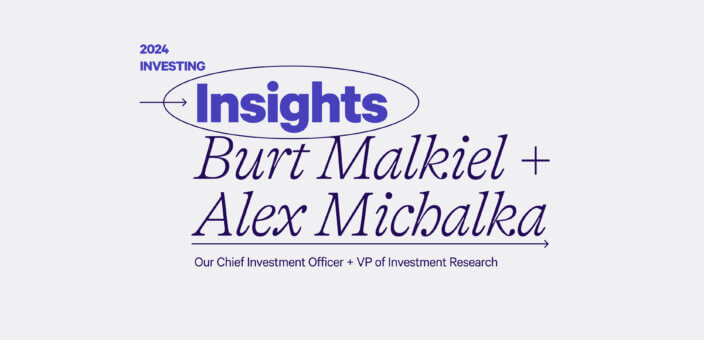In planning your investment strategy for 2024 and beyond, there are wise principles to keep in mind: While no one can predict how market prices will move in any particular period, there are time-tested general rules that can put the odds of success squarely in your favor. In this letter we will offer some simple suggestions that have been highly effective in reducing risk and improving the likelihood that your investment portfolio will grow over time.
Regular saving and investing over time is the surest way of building a portfolio that will accumulate wealth and will ultimately provide the means for a comfortable retirement. By consistently adding funds to your investment account, you will take advantage of what is called “dollar cost averaging.” As shown in the exhibit that follows, an investor putting $1,000 per period in the stock market can make more money in a volatile but flat market than can be achieved in a steadily rising market. The reason is that, as this example illustrates, the investor buys more shares when the market is down than when it is up and thus the average cost of the shares purchased is lower in the volatile flat market than the rising market. While the illustration is obviously a cooked-up example, the real-life investor who dollar cost averaged during poor market periods actually came out well ahead. During the 1970s and first decade of the 2000s, the market was volatile and ended the decade just where it began. But a dollar cost averaging investor buying US equities made the average return of between 5 and 6% per year with dividends reinvested during each of those decades. Thus, money can be made in the stock market even if it doesn’t go up.

Broad diversification can also help by reducing the risks of investing. Diversified exposure to common stocks should comprise the lion’s share of every portfolio where the long-run objective is the accumulation of wealth. Equities have provided generous long-run returns and have been an excellent inflation hedge. But returns are likely to be smoother if they are broadly diversified and include international as well as domestic equities. Diversification also reduces risk if you choose to have a significant portfolio weight in one sector such as technology stocks. And some exposure to bonds, including those whose returns are indexed to inflation, will reduce a portfolio’s risk.
Rebalancing is another time-tested technique to constrain risk. If, for example, emerging-market stocks soared in a particular period, they can be pared back with the proceeds distributed to other asset classes, in order to preserve optimal portfolio diversification.
Minimization of taxes is another essential practice to optimize investment results. Investors can benefit from taking advantage of their employer’s retirement plan as well as individual plans such as Roth IRAs. For all monies invested that are taxable, tax-loss harvesting (TLH) can substantially improve after-tax returns. TLH involves selling an individual stock or fund at a loss and replacing it with a similar (but not identical) one to maintain the diversification of the portfolio. While TLH does not increase pre-tax returns, it can add a significant amount to after-tax returns, especially when the tax savings are reinvested. Direct indexing significantly improves the effectiveness of tax-loss harvesting.
While you can’t influence the level of security prices, you can control your investment costs. Costs can be minimized and returns enhanced by using index funds rather than actively managed funds. Studies by Standard & Poor’s have consistently shown that index funds outperform actively managed funds. The results of the most recent study are shown in the table that follows. During the 12 months ending June 30, 2023, over 70% of actively managed funds were outperformed by the broad (S&P 1500) total stock market index. While close to 30% of the active funds did better, there is no consistency to superior performance. Beating the market in one year does not predict that you will do so in the next. Thus, when results are compounded over 10 and 20 years, over 90% of active funds do worse than their benchmark index. Note that a low-cost index fund isn’t likely to beat the index either because of the ETF’s expense ratio, but it should be very close. Over the past 20 years, SPTM (a low-cost ETF tracking the S&P 1500) returned 9.97% per year while the average active fund returned 8.31%, a difference of well over 1 percentage point per year. The generally lower cost of index funds contributes to their ability to outperform active funds over longer periods of time. And indexing works in global and real estate markets as well as bond markets. The core of every portfolio ought to consist of index funds.

Investing consistently over time to take advantage of dollar-cost averaging, using index funds as core investment vehicles, broad diversification, risk management, rebalancing, tax smart investing including tax-loss harvesting: these are the fundamental principles behind Wealthfront portfolios. This is why I am an enthusiastic member of the investment team and am a Wealthfront client myself. To be sure, similar services are available from wealth managers who cater to the extremely wealthy. But these managers charge one, two, or even three percent of the amount invested for their services each year. By using software, Wealthfront provides these services for a quarter of one percent per year while also avoiding conflicts of interest that are present with many wealth managers. Wealthfront also provides one of the highest APYs available for monies held in ultra-safe short-term accounts. One of the truest sayings about finances was the favorite expression of the late Jack Bogle: “In investing, you get what you don’t pay for.”
Disclosure
The information contained in this communication is provided for general informational purposes only, and should not be construed as investment or tax advice. Nothing in this communication should be construed as tax advice, a solicitation or offer, or recommendation, to buy or sell any security. Any links provided to other server sites are offered as a matter of convenience and are not intended to imply that Wealthfront Advisers, Wealthfront Brokerage or any affiliate endorses, sponsors, promotes and/or is affiliated with the owners of or participants in those sites, or endorses any information contained on those sites, unless expressly stated otherwise.
Investors may experience different results from the figures shown in the charts above. No representation is being made that any client account will achieve performance returns similar to those demonstrated. The returns presented are for illustrative purposes only and are not indicative of any particular investment outcome. It should be noted that the assumptions underlying these returns have not been exhaustively detailed and may not encompass all factors relevant to actual investment results. Changes in these assumptions or in market, economic, legal, or regulatory conditions can significantly affect the illustrated returns. Actual investment results, performance, or events may materially differ due to various factors including, but not limited to, general economic conditions, performance of financial markets, and changes in laws and regulations.
The dollar cost averaging illustration is a simplified representation for educational purposes and does not account for factors such as dividends, taxes, transaction fees, or other real-world considerations. Actual investment outcomes will vary based on market performance and other factors.
Wealthfront’s “Percentage of US Equity Funds Underperforming Index Returns Compounded Over 1, 10, and 20 Years” chart is derived from data sourced from S&P Dow Jones Indices LLC and CRSP, as of June 30, 2023. This chart presents a composite view of equity fund performance, using absolute return metrics and adhering to General SPIVA scorecard fundamental principles. The analysis incorporates survivorship bias correction, providing a complete set of fund data across the defined time frames. This approach ensures a balanced representation of both surviving and non-surviving funds. Each fund’s performance is compared against benchmarks that are most relevant to its investment category. The analysis includes both asset and equal-weighted averages in the SPIVA scorecards. Data cleaning processes are implemented to avoid double-counting of multiple share classes, using only the share class with greater assets for each fund. The results presented are based on historical data and do not guarantee future performance.
Wealthfront Advisers and its affiliates do not provide legal or tax advice and do not assume any liability for the tax consequences of any client transaction. Clients should consult with their personal tax advisors regarding the tax consequences of investing with Wealthfront Advisers and engaging in these tax strategies, based on their particular circumstances. Clients and their personal tax advisors are responsible for how the transactions conducted in an account are reported to the IRS or any other taxing authority on the investor’s personal tax returns. Wealthfront Advisers assumes no responsibility for the tax consequences to any investor of any transaction.
The effectiveness of the tax-loss harvesting strategy to reduce the tax liability of the client will depend on the client’s entire tax and investment profile, including purchases and dispositions in a client’s (or client’s spouse’s) accounts outside of Wealthfront Advisers and type of investments (e.g., taxable or nontaxable) or holding period (e.g., short- term or long-term).
Diversification and dollar-cost averaging do not guarantee a profit or protect against loss in declining markets.
All investing involves risk, including the possible loss of money you invest, and past performance does not guarantee future performance. Historical returns, expected returns, and probability projections are provided for informational and illustrative purposes, and may not reflect actual future performance. Please see our Full Disclosure for important details.
Investment management and advisory services are provided by Wealthfront Advisers LLC (“Wealthfront Advisers”), an SEC-registered investment adviser, and brokerage related products, including the cash account, are provided by Wealthfront Brokerage LLC, a Member of FINRA/SIPC.
Wealthfront, Wealthfront Advisers and Wealthfront Brokerage are wholly owned subsidiaries of Wealthfront Corporation.
Copyright 2024 Wealthfront Corporation. All rights reserved
About the author(s)
Alex Michalka, Ph.D, has led Wealthfront’s investment research team since 2019. Prior to Wealthfront, Alex held quantitative research positions at AQR Capital Management and The Climate Corporation. Alex holds a B.A. in Applied Mathematics from the University of California, Berkeley, and a Ph.D. in Operations Research from Columbia University. View all posts by Alex Michalka, Ph.D
Dr. Burton G. Malkiel, the Chemical Bank Chairman’s Professor of Economics, Emeritus, and Senior Economist at Princeton University, is Wealthfront's Chief Investment Officer. Dr. Malkiel is the author of the widely read investment book, A Random Walk Down Wall Street, which helped launch the low-cost investing revolution by encouraging institutional and individual investors to use index funds. Dr. Malkiel, also the author of The Elements of Investing, is one of the country’s leading investor advocates. View all posts by



